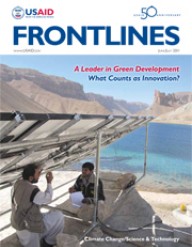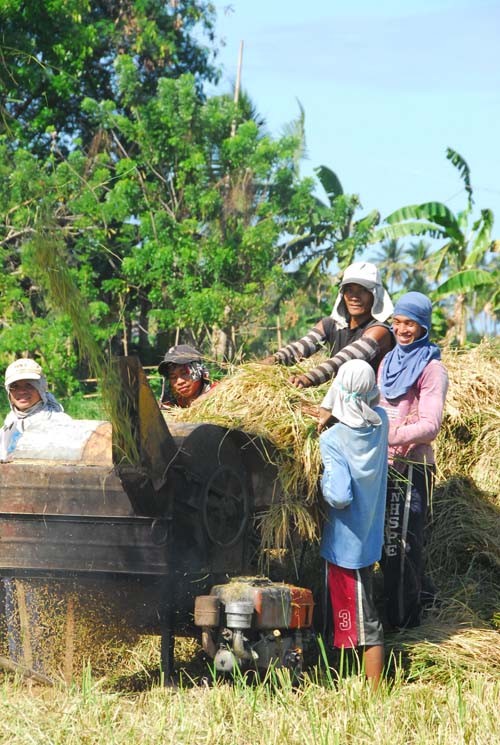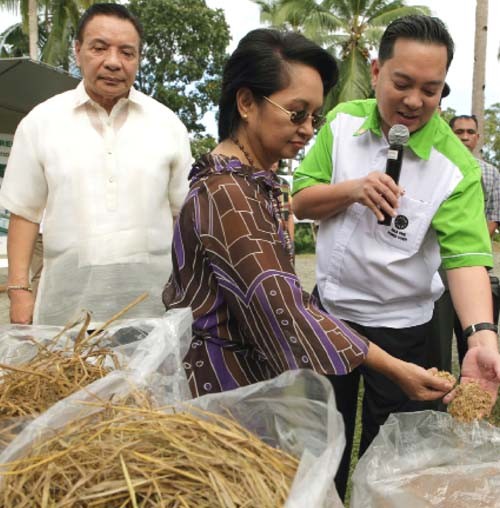 Farmers in Aklan province will be able to generate additional income by selling their rice husks to Asea One for use in the nearby biomass power plant.They will also share in the profits of the plant.
Nick Keyes
Farmers in Aklan province will be able to generate additional income by selling their rice husks to Asea One for use in the nearby biomass power plant.They will also share in the profits of the plant.
Nick Keyes
 Farmers in Aklan province will be able to generate additional income by selling their rice husks to Asea One for use in the nearby biomass power plant.They will also share in the profits of the plant.
Nick Keyes
Farmers in Aklan province will be able to generate additional income by selling their rice husks to Asea One for use in the nearby biomass power plant.They will also share in the profits of the plant.
Nick Keyes
KALIBO, Philippines—Ronaldo Zeque’s mill, outside this provincial capital, processes 300 sacks of rice each day. Afterwards, there are truckloads of husks to be discarded.
“We burn all our rice husks,” says Zeque. “We don’t have a choice. But we worry about the health hazards.”
As well he should. The constant burning behind his mill creates a dangerous haze for his workers and pollutes the surrounding area. This hazard should soon disappear, however.
Zeque has signed a contract with Asea One Power Corp. to sell his rice husks to a power plant that will provide carbon-free electricity while supplying more than one-quarter of the electricity needs of Aklan province, where Kalibo is located. And what helps his community also helps him: Zeque will have two sources of income from the sale of the rice husks, based on a pre-arranged unit price, and from a profit-sharing arrangement with Asea One. In fact, local farmers and millers who supply Asea One will receive 10 percent of the after-tax profits from the power plant developer.
Asea One is one of 21 companies in Asia that have launched new clean energy projects as a result of a USAID-supported initiative called the Private Financing Advisory Network (PFAN). Until PFAN, dozens of small- and medium-sized clean energy businesses (involving $1 million to $50 million investments) like Asea One—which should be the most dynamic sector of the clean energy market—struggled to find financing, which is much more easily available for conventional, larger types of energy-sector investments. PFAN bridges that gap.
Launched in 2006 by the United States and 10 other donors, this global partnership initially focused on Africa and Latin America. In April 2009, the USAID Regional Development Mission for Asia (RDMA) brought PFAN to Asia. Since then, PFAN-Asia has also included funding from USAID/Indonesia and the U.S. Department of State.
Asia’s Energy and Environmental Challenge
Asia’s dramatic economic expansion over the past few decades has led to unprecedented reductions in poverty. But it has also led to serious strains on the region’s environmental and health conditions. It is estimated that emissions of greenhouse gases in developing Asia from all energy sources will increase by about 55 percent by 2030. In the meantime, Asia’s increasing reliance on energy imports has already led to increasing budget deficits and deep concerns about energy security.
In short, Asia needs clean energy—as quickly and efficiently as possible.
“Asia has the highest rate of growth in energy demand in the world and demand is expected to more than double by 2035,” said Winston Bowman, regional environment director, RDMA. “Without new market and policy incentives for clean energy, Asia’s continued reliance on fossil fuels will create enormous pressures on the environment, globally and locally.”
But significant challenges remain before Asia can look to its low-carbon future. One of the most important is the inability of small and medium enterprises, which should be powerful drivers of the region’s transformation, to find adequate financing for new clean energy projects.
That is where USAID and PFAN come in.
A Clean Energy Match-Maker
The problem is straightforward: clean energy developers and entrepreneurs are looking for project financing at the same time that financial institutions and private investors are looking for investment opportunities in the fast-growing clean energy market. But developers often lack the business skills to effectively pitch their projects to financial institutions. And financial institutions often lack the knowledge—and hence the confidence—to invest in renewable energy and energy efficiency.
Enter PFAN. Its network of consultants, business coaches, and mentors act as honest brokers for project developers and investors alike, bringing the essential knowledge and skills together to structure deals that work.
“PFAN has been able to find an effective niche and have a transformative impact in the clean energy marketplace in Asia,” says Michael Yates, mission director for USAID/RDMA. “The network’s specialists work with project developers and help refine their business plans so they are ready for investors. They also work the other side, and help develop investors’ technical and market knowledge about renewable energy and energy-efficiency financing.”
PFAN selects the most promising projects from local entrepreneurs for mentoring, technology development, and feasibility before presenting them to investors at signature events.
Besides demonstrating greenhouse gas reductions, projects are chosen on the basis of six criteria—potential for profitability, competent management, innovation or uniqueness, scalability, social responsibility, and demonstrated environmental benefits.
PFAN projects vary considerably, including biogas, biomass, mini and micro hydropower, energy efficiency, solar photovoltaic, and electric vehicles. In a number of cases, the work takes place in areas that are historically underserved.
Success in Asia
Back in Aklan, at Ronaldo Zeque’s mill, the PFAN model has succeeded in making an entrepreneur out of a potential polluter. The power plant will help Zeque not only deal with agricultural waste, but also make him a partner in the new electricity venture. The new 12-megawatt plant will run entirely on agricultural waste—rice straw and rice husks—that farmers would otherwise throw away or burn.
By using local biomass materials for the power plant instead of importing power generated by coal or diesel plants in neighboring provinces, the plant will avoid 40,000 metric tons of carbon dioxide (CO2) each year, equivalent to planting more than a million trees. Generating electricity from biomass is carbon neutral because the CO2 that is emitted when the rice husks are converted into electricity is recaptured in rice crops during the following growing season.
Since 2009, RDMA and PFAN have established networks in the Philippines, Indonesia, India, and China as well a regional financing network across Southeast Asia. During this period, more than 100 projects have been mentored by PFAN and presented to Asian investors, and 21 projects in six countries have received financial commitments that will allow them to proceed.
As of this June, PFAN activities in Asia had leveraged more than $274 million in financial deals for renewable energy and energy efficiency projects based on a $3.4 million USAID investment. Combined, these are expected to provide 138 megawatts of clean energy and eliminate the equivalent of 12.2 million metric tons of carbon dioxide over project lifetimes—equivalent to taking 2.3 million cars off the road for one year.
“By any measure, the PFAN model is a very effective use of USAID resources,” says Yates. “PFAN works. We should take this model and run with it.”
Peter du Pont is chief of party, ECO-Asia Clean Development and Climate Program—an RDMA implementing partner. Orestes Anastasia is a regional environment adviser at RDMA.
-
A facility in Thaklong, Thailand, that will turn 350 metric tons of municipal waste per day into biogas and synthetic gas, which can be burned to generate electricity;
-
A plant to procure power and heat from waste at a tapioca plant in Kampong Cham province, Cambodia;
-
Generators at a steel mill in North Sumatra, Indonesia, that will use local agricultural waste to produce power for the operation of the mill and the surrounding community;
-
A mini-hydro power plant in Pakkat District, North Sumatra, Indonesia, that will provide clean power, stimulating economic growth in an under-served region of the country; and
-
A multiple-feedstock system in Quezon province, the Philippines, that will convert organic waste from a local pig farm and agricultural waste from local farmers into power and fertilizer.











Comment
Make a general inquiry or suggest an improvement.